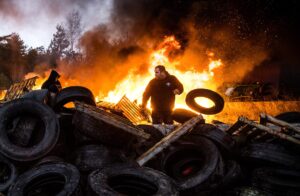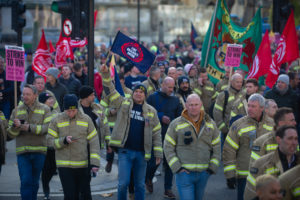People fret about how high the divorce rate has become; it’s at a 60-year low. People talk about how the United States has lost its status as an educational powerhouse; but we’ve done terribly for as long as there has been rigorous international comparisons. Even though we live in a world of unlimited information, many people believe things that just aren’t true. I bring this up as a form of confession: when it comes to the labour movement in the United States I do the same — possibly for self-defensive reasons.
In day-to-day life, I unthinkingly conceive of our current era as one of union ascendancy. The rise of the Bernie Sanders Democrat helped push labour back to the forefront of Left-of-centre debate: where Clintonite neoliberals found unions distasteful, today’s young liberals are reflexively pro-labour. Joe Biden’s National Labor Review Board, easily the most influential body for such issues in the United States, is the most union-friendly iteration in generations. And there have been a number of high-profile battles in recent years — everywhere from Amazon warehouses to Starbucks coffee shops. Actors’ and screenwriters’ unions held long and more-or-less successful strikes last year. In short, there is more coverage of and excitement about union issues right now than at any other point in my adult life.
And yet, Reuters tells us, last year, the American unionisation rate fell slightly, to a record low of 10%. In the metric that matters, unions are stagnant or declining. That contradiction begs a question: why has the renewed abstract interest in labour movements not coincided with an increase in actually-existing workers joining actually-existing unions?
Americans are interested in unions because we’ve spent decades in a system with no counterweight to the influence of capital. After a half-century of spiralling inequality, repetitive scandals in our banking and finance sector, and stagnation in salaries for ordinary workers, there has been a broad embrace of further-Left politics. But the American conservative movement has fought vociferously for over a century to disempower labour — and they’re aided in this fight by the corporations and plutocrats that would be hurt by more and more powerful unions. The laws are bent against organising.
For generations, Republicans have been the labour movement’s persistent, passionate foe, while Democrats have been only tentatively committed to it. It seems strange that the institutions of the American Left haven’t done more to revitalise unions, given how much they empower workers. (If you’d like a prominent example, last year UPS described the demands of the Teamsters Union that represents its workers as extortionate for months — then folded once an actual work stoppage drew near.) But then again, corporations have almost as much influence in the Democratic party as they do with the Republicans.
Hamilton Nolan, a heart-on-his-sleeve labour leftist who has done as much as any journalist of his generation to centre unions, is inspired by the maddening reality that, even though labour organising is one of the most consistently potent forms of Left-wing power, it is constantly marginalised by the Democrats and establishment liberals. His recent book, The Hammer, laments years of bad decisions by union management, before issuing a call to action, concerning how the movement could grow. It’s the argument of a pessimist’s intellect and an optimist’s soul. Which is pretty much the only combination that makes sense if you are, like Nolan and myself, a supporter of America’s unions.
Organising is harder than it used to be. One of the virtues of The Hammer is it reminds us how much of it now takes place in worksites that look nothing like a car assembly plant. The advantages of the factory were multiple for unions: these were centralised workplaces with significant employee populations, and often the largest and most important employer for a local community. The actual work was frequently dangerous and physically demanding. Those conditions lent themselves to workers coming together to demand better pay and conditions.
Nolan points out that the effectiveness of the culinary unions in Nevada, one of the major recent labour success stories, is down to similar reasons:
“Just as the United Mine Workers, the United Steelworkers, and the United Auto Workers grew out of factory towns where workers chafed under the iron hand of all-powerful companies, so, too, has the Culinary Union’s growth been driven by a clear-eyed understanding that they were the only thing standing between thousands of workers and a life of absolute domination by casino companies.”
But most modern workplaces are not like factories. Workforces tend to be atomised into various departments and offices, and their interactions are often limited and filtered through electronic mediums. The most dangerous threat to such workers is often a papercut. It’s harder to muster the motivation to organise.
But the union movement can’t afford to stand around being nostalgic; the old model of factory unions, though still in place in a few industries, can’t be the model. It’s common for people to scoff at the idea of having unions in workplaces like Starbucks or, for that matter, Gawker Media, where I first encountered Nolan’s work. But unions must go where the jobs are and, most of all, where the employees who want to be organised are.
I frequently thought of two different sets of workers as I read The Hammer: home health aides — or carers — and people like me.
You often see home health aides named as perhaps the fastest-growing profession in the United States. America is a rapidly-greying country, with a vast population of ageing Baby Boomers reaching their senescence; we’re also a society where the average number of children per family has significantly declined and where multigenerational living has become uncommon. This is a recipe for a lot of senior citizens who need help getting around their homes, preparing meals, taking their medicines. Hence the rise of the home health aide, people who are often paid by Medicare or various government assistance programs — and paid poorly, at around $10/hour. Benefits are often minimal, and these carers are afforded little social status. This is a group that could definitely benefit from union representation, and unions would be very happy to increase their ranks with such a large and growing worker base.
And yet, organising this group is difficult, despite efforts by The Service Employees International Union (SEIU), and the Home Healthcare Workers of America (HHWA). These workers rarely or ever congregate in a central place of employment; the vast majority of their working hours are spent in the homes of their clients. So, there’s little opportunity for the organic back-and-forth that has been so crucial to unionising workplaces in the past. The lack of a site of organising means it’s hard for union organisers to introduce themselves to employees — to make the case for unionising, or explain where dues go. And given its low-paying nature, the profession is fairly transient, with many people drifting into and out of these jobs.
Though dogged efforts to organise fast food workers continue, there, too, the lack of stability in the workforce poses problems for unions: employees who stay on the job for a matter of months, or who frequently leave and return to employment, are less likely to be enthusiastic union members. They have less natural investment in the working experience.
And then there are people like me. Digital media has been a rare bright spot in the labour movement, with a broad expansion of workplace organising — although the industry has been subject to such violent contraction that it’s hard to feel good about that growth. More and more of my peers are turning to a crowdsourced model of funding, with subscription-based newsletters or similar; Nolan himself derives some of his income this way. Though I freelance for publications such as this one and am steadily writing books, the bulk of my income stems from a paid newsletter. I would like to be part of a union, as I was when in the American Federation of Teachers. But it really wouldn’t make much sense. I don’t control the means of my production — Substack does, thanks to owning its servers — but I also have no specific employer. I’m not living on the rents derived from ownership, but I also have no management with which I can negotiate. It’s hard to imagine how I could ever belong to a union in this capacity, and yet the fact remains that I work, and that corporations capture the value I create, resulting in my exploitation. If the labour movement can’t incorporate independent contractors like me — somehow, some way — it’s losing out on a large and growing slice of the workforce. But incorporate us how?
Nolan offers no easy answers. Indeed, his book catalogues mistake after mistake made by the labour movement. This willingness to engage directly and unapologetically with a seemingly endless stream of self-inflicted wounds is one of the book’s central strengths — a sign that labour is more than a symbol for Nolan and instead a living, breathing engine of potential progress. And yet, The Hammer’s bifurcated status, as both an invocation of labour’s potential and an indictment of its present reality, made the book frequently feel at war with itself. It’s too worshipful towards what labour might be to function as a screed, and too repetitively pessimistic to serve as a rousing call to action. And that’s fine! It doesn’t have to be either. But when I’ve recommended the book to friends, I’ve struggled to tell them exactly what it is. Every statement of hope seems offset by a discouraging detail.
But if the book sometimes seems unsure of its own level of optimism, the state of Nolan’s heart is clear. He has said, in describing the genesis of the book: “I could see, as clear as day, how unions could be the singular tool that could solve the inequality crisis gripping America — the big, deep problem that was eroding the foundations of our society, the underlying cause of a lot of other problems.” If this is an exaggeration, it’s barely one; the ability to bring work to a halt still represents just as much of a threat to plutocratic rule as it always did. Labour is never far from the heart of Left-wing politics, can never be; the Left is labour. For however unfashionable Marxism may be now, the fact that the most important Left-wing movement of all time placed the relationship between workers and management at the heart of political struggle holds a lesson for the rest of us.
And at the same time, the situation frequently does seem hopeless. Politicians from one party occasionally invoke unions as a feel-good afterthought; those from the other party relentlessly work to make labour organising impossible. Many Americans still reflexively see unions as synonymous with worker greed and laziness, after being force-fed a steady drip of Reaganite propaganda. And as in all things in 21st-century life, the workplace seems destined to remain under the tight grip of an unaccountable financial elite that government won’t confront and certainly can’t control.
Ultimately, The Hammer left me grasping at the same platitudes that I always grasp at when it comes to the labour movement — pessimism of the intellect, optimism of the will; workers of the world, unite, you have nothing to lose but your chains. The potential for a muscular American union movement, a lever of power in a world where workers have precious little, will never be erased. But only we can take advantage of such power, and it’s hard not to conclude that we simply don’t want to.
I know Nolan wants to believe that American unions can rise again, but I’m not sure he actually believes that American unions can rise again. I know how he feels. I’m living in the space between realism and idealism, between the potential and the actual, and it seems that so is he. The urge for workers to organise in some capacity to secure better working conditions will never leave us, and as long as that is true there is hope for unions. But precisely because of the heights reached in the heyday of American labour, now literally a century ago, the forces of reaction are that much more committed to defeating the threat of organised workers. And yet still, I can’t deny: there is power in a union.
Disclaimer
Some of the posts we share are controversial and we do not necessarily agree with them in the whole extend. Sometimes we agree with the content or part of it but we do not agree with the narration or language. Nevertheless we find them somehow interesting, valuable and/or informative or we share them, because we strongly believe in freedom of speech, free press and journalism. We strongly encourage you to have a critical approach to all the content, do your own research and analysis to build your own opinion.
We would be glad to have your feedback.
Source: UnHerd Read the original article here: https://unherd.com/






